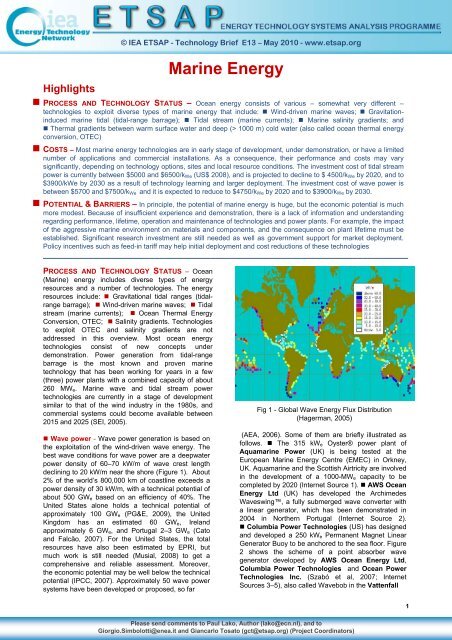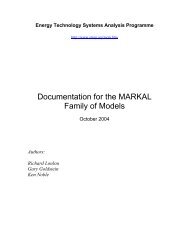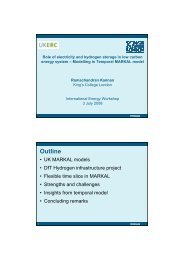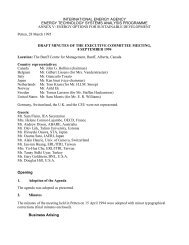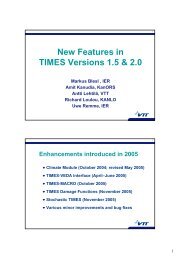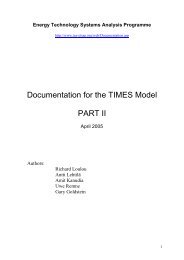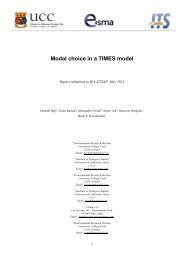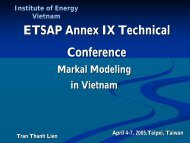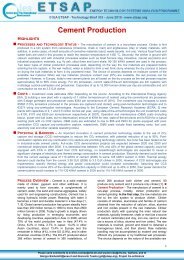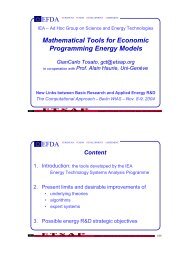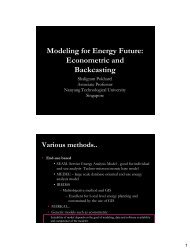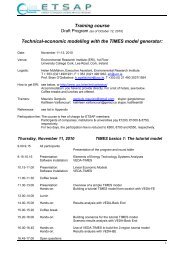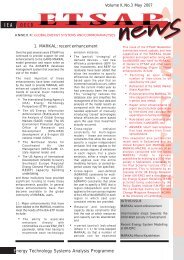Marine Energy - iea-etsap
Marine Energy - iea-etsap
Marine Energy - iea-etsap
You also want an ePaper? Increase the reach of your titles
YUMPU automatically turns print PDFs into web optimized ePapers that Google loves.
© IEA ETSAP - Technology Brief E13 – May 2010 - www.<strong>etsap</strong>.org<br />
<strong>Marine</strong> <strong>Energy</strong><br />
Highlights<br />
• PROCESS AND TECHNOLOGY STATUS – Ocean energy consists of various – somewhat very different –<br />
technologies to exploit diverse types of marine energy that include: • Wind-driven marine waves; • Gravitationinduced<br />
marine tidal (tidal-range barrage); • Tidal stream (marine currents); • <strong>Marine</strong> salinity gradients; and<br />
• Thermal gradients between warm surface water and deep (> 1000 m) cold water (also called ocean thermal energy<br />
conversion, OTEC)<br />
• COSTS – Most marine energy technologies are in early stage of development, under demonstration, or have a limited<br />
number of applications and commercial installations. As a consequence, their performance and costs may vary<br />
significantly, depending on technology options, sites and local resource conditions. The investment cost of tidal stream<br />
power is currently between $5000 and $6500/k We (US$ 2008), and is projected to decline to $ 4500/k We by 2020, and to<br />
$3900/kWe by 2030 as a result of technology learning and larger deployment. The investment cost of wave power is<br />
between $5700 and $7500/k We and it is expected to reduce to $4750/k We by 2020 and to $3900/k We by 2030.<br />
• POTENTIAL & BARRIERS – In principle, the potential of marine energy is huge, but the economic potential is much<br />
more modest. Because of insufficient experience and demonstration, there is a lack of information and understanding<br />
regarding performance, lifetime, operation and maintenance of technologies and power plants. For example, the impact<br />
of the aggressive marine environment on materials and components, and the consequence on plant lifetime must be<br />
established. Significant research investment are still needed as well as government support for market deployment.<br />
Policy incentives such as feed-in tariff may help initial deployment and cost reductions of these technologies<br />
________________________________________________________________________<br />
PROCESS AND TECHNOLOGY STATUS – Ocean<br />
(<strong>Marine</strong>) energy includes diverse types of energy<br />
resources and a number of technologies. The energy<br />
resources include: • Gravitational tidal ranges (tidalrange<br />
barrage); • Wind-driven marine waves; • Tidal<br />
stream (marine currents); • Ocean Thermal <strong>Energy</strong><br />
Conversion, OTEC; • Salinity gradients. Technologies<br />
to exploit OTEC and salinity gradients are not<br />
addressed in this overview. Most ocean energy<br />
technologies consist of new concepts under<br />
demonstration. Power generation from tidal-range<br />
barrage is the most known and proven marine<br />
technology that has been working for years in a few<br />
(three) power plants with a combined capacity of about<br />
260 MW e . <strong>Marine</strong> wave and tidal stream power<br />
technologies are currently in a stage of development<br />
similar to that of the wind industry in the 1980s, and<br />
commercial systems could become available between<br />
2015 and 2025 (SEI, 2005).<br />
• Wave power - Wave power generation is based on<br />
the exploitation of the wind-driven wave energy. The<br />
best wave conditions for wave power are a deepwater<br />
power density of 60–70 kW/m of wave crest length<br />
declining to 20 kW/m near the shore (Figure 1). About<br />
2% of the world’s 800,000 km of coastline exceeds a<br />
power density of 30 kW/m, with a technical potential of<br />
about 500 GW e based on an efficiency of 40%. The<br />
United States alone holds a technical potential of<br />
approximately 100 GW e (PG&E, 2009), the United<br />
Kingdom has an estimated 60 GW e , Ireland<br />
approximately 6 GW e , and Portugal 2–3 GW e (Cato<br />
and Falcão, 2007). For the United States, the total<br />
resources have also been estimated by EPRI, but<br />
much work is still needed (Musial, 2008) to get a<br />
comprehensive and reliable assessment. Moreover,<br />
the economic potential may be well below the technical<br />
potential (IPCC, 2007). Approximately 50 wave power<br />
systems have been developed or proposed, so far<br />
Fig 1 - Global Wave <strong>Energy</strong> Flux Distribution<br />
(Hagerman, 2005)<br />
(AEA, 2006). Some of them are briefly illustrated as<br />
follows. • The 315 kW e Oyster® power plant of<br />
Aquamarine Power (UK) is being tested at the<br />
European <strong>Marine</strong> <strong>Energy</strong> Centre (EMEC) in Orkney,<br />
UK. Aquamarine and the Scottish Airtricity are involved<br />
in the development of a 1000-MW e capacity to be<br />
completed by 2020 (Internet Source 1). • AWS Ocean<br />
<strong>Energy</strong> Ltd (UK) has developed the Archimedes<br />
Waveswing, a fully submerged wave converter with<br />
a linear generator, which has been demonstrated in<br />
2004 in Northern Portugal (Internet Source 2).<br />
• Columbia Power Technologies (US) has designed<br />
and developed a 250 kW e Permanent Magnet Linear<br />
Generator Buoy to be anchored to the sea floor. Figure<br />
2 shows the scheme of a point absorber wave<br />
generator developed by AWS Ocean <strong>Energy</strong> Ltd,<br />
Columbia Power Technologies and Ocean Power<br />
Technologies Inc. (Szabó et al, 2007; Internet<br />
Sources 3–5), also called Wavebob in the Vattenfall<br />
1<br />
Please send comments to Paul Lako, Author (lako@ecn.nl), and to<br />
Giorgio.Simbolotti@enea.it and Giancarlo Tosato (gct@<strong>etsap</strong>.org) (Project Coordinators)
© IEA ETSAP - Technology Brief E13 – May 2010 - www.<strong>etsap</strong>.org<br />
version. • Ocean <strong>Energy</strong> Ltd (Ireland) developed a<br />
floating platform with a turbine (OE Buoy for use in<br />
water depths of 30–50 m (Internet Sources 6–7).<br />
Figure 3 shows the so-called oscillating water column<br />
(Mueller et al, 2007), a principle used by Ocean<br />
<strong>Energy</strong> Ltd and the so-called Limpet by Voith Hydro<br />
Wavegen Ltd. • Ocean Power Technologies Inc.<br />
(OPT, US) designed the PowerBuoy®. Tests of the<br />
device started in December 2009 at Kaneohe Bay<br />
(Hawaii). It will also be deployed at EMEC in Orkney,<br />
(UK). Nine PowerBuoys of 150 kW e each, with a total<br />
capacity 1.39 MW e , will be installed at 5 km off the<br />
Santoña coast, Spain (Internet Sources 8–9). •<br />
Pelamis Wave Power Ltd (PWP, UK) developed a<br />
750 kW e Pelamis module, consisting of three units of<br />
250 kW e each, for mooring in 50–70 m deep water at<br />
5–10 km from the shore. In 2008, a three-module<br />
Pelamis project of 2.25 MW e was commissioned for<br />
installation off the coast of Portugal (Figure 4). PWP<br />
has also announced an order from E.On for a 2 nd<br />
generation module to be installed in Orkney, followed<br />
by four modules with a capacity of 3 MW e (Wise, 2008;<br />
Internet Sources 10–13). • Voith Hydro Wavegen<br />
Ltd (UK) developed the Limpet, an overtopping device<br />
optimised for near-shore applications, with a 7-m wave<br />
depth at the entrance of an Oscillating Water Column<br />
(OWC). The OWC feeds a pair of counter-rotating<br />
turbines driving a 250 kW e generator, with a total<br />
capacity of 500 kW e (Heath, 2007; Internet Source 14).<br />
• Vattenfall provides financial support for the<br />
demonstration of three wave energy technologies<br />
including Pelamis (PWP Ltd), Wavebob (Wavebob<br />
Ltd), and a device developed by Seabased (Sweden)<br />
(Internet Sources 15–16). The Wavebob is an axisymmetric,<br />
self-reacting point absorber (primarily<br />
operating in heave mode) to produce power from<br />
ocean wave energy. According to Rodrigues (2005),<br />
wave power could become commercial at a cumulative<br />
capacity of about 7000 MW e . If issues such as<br />
corrosion, materials, connection to the shore, possible<br />
conflict with fishing, and environmental impacts are<br />
solved, then wave power might become commercial<br />
around 2020.<br />
• Tidal power - Tidal power is based on two<br />
technologies, namely tidal barrage power and tidal<br />
stream power (marine currents). • Tidal barrage is<br />
based on capturing seawater by a barrage when the<br />
tidal is high, and let the water flow through hydroturbines<br />
when tidal is low. There are only three plants in<br />
operation worldwide, with a combined capacity of 260<br />
MW e . A tidal barrage at Severn (UK) would have a<br />
maximum capacity of 8.6 GW e and an average capacity<br />
of 2.0 GW e (SDC, 2007). According to the Internet<br />
Source 18, environmental concerns make it socially<br />
unacceptable the Severn tidal barrage. Unfortunately,<br />
the number of coastal sites where tidal barrages are<br />
economically and environmentally feasible is very<br />
limited. Costly large barrages projects are under<br />
consideration to take into account the conservation of<br />
marine habitats. An indicator of the cost effectiveness of<br />
a tidal barrage power plant is the so-called Gibrat ratio<br />
that is the length of the barrage (in meters) to the<br />
Fig 2 - Scheme of point absorber used by AWS,<br />
Columbia Power Technologies and Ocean Power<br />
Technologies (Internet Source 5)<br />
Fig 3 - Scheme of oscillating water column used by OE<br />
Buoy and Limpet (Mueller et al, 2007)<br />
Fig 4 - One of three sections of the 750 kWe Pelamis,<br />
Aguçadura, Portugal (Internet Source 11)<br />
annual energy production (in KWh) ratio. Of course,<br />
smaller Gibrat ratios are desirable. For example, the<br />
Gibrat ratio for the current tidal power plant at la Rance<br />
(France) is 0.36, whereas the Gibrat ratio of the<br />
planned tidal power plant at the Severn (UK) would be<br />
0.87 (Soriano, 2008). Based on the Gibrat ratio and<br />
other indicators and considerations, the global potential<br />
of tidal barrage power plants is estimated to amount to<br />
2<br />
Please send comments to Paul Lako, Author (lako@ecn.nl), and to<br />
Giorgio.Simbolotti@enea.it and Giancarlo Tosato (gct@<strong>etsap</strong>.org) (Project Coordinators)
© IEA ETSAP - Technology Brief E13 – May 2010 - www.<strong>etsap</strong>.org<br />
approximately 60 GW e , with an electricity generation of<br />
about 150 TWh/year (Gorlov, 2001). • Tidal stream<br />
power can be considered as a demonstrated<br />
technology on the basis of the existing installations and<br />
technology advances (see Figure 5). In 2003,<br />
Hammerfest Strøm installed the world’s first-of-thekind<br />
300-kWe tidal turbine prototype in Kvalsundet, off<br />
Hammerfest. In 2007, they also signed a contract with<br />
Scottish Power for further technology development<br />
(Internet Sources 18–19). In 2006, Verdant Power (US<br />
and Canada) started the Roosevelt Island Tidal <strong>Energy</strong><br />
(RITE) project in New York City’s East River. Phases 1<br />
and 2 involved testing and demonstrating a 35-kW e<br />
Kinetic Hydro Power System (KHPS) prototype (Figure<br />
6). In the phase 3 of the project, the prototype is to be<br />
scaled up to MW-size (Internet Source 20). In 2008,<br />
OpenHydro (Ireland) installed a 250-kW e prototype at<br />
EMEC (Internet Source 25); Tocardo (Netherlands)<br />
demonstrated a 45-kW e turbine, with a direct drive, 2-<br />
bladed rotor at Afsluitdijk (Internet Source 22); and<br />
<strong>Marine</strong> Current Turbines Ltd (UK) moored a 1.2-MW e<br />
SeaGen tidal stream unit at Strangford Lough (UK). The<br />
next phase of this project includes the installation of<br />
seven 1.5-MW e SeaGen turbines with a total capacity of<br />
10.5 MW e near the island of Anglesey, also known as<br />
The Skerries (Figure 7; Internet Sources 23–24). In<br />
2009, Fri-El Green Power started the tests of a 500-<br />
kW e tidal stream pilot plant called Fri-El Sea Power in<br />
the Strait of Messina between Sicily and the mainland<br />
of Italy. Sea Power has been developed for either<br />
power generation from tides, oceanic circulations or for<br />
exploiting natural flow water streams (Figure 8; Internet<br />
Source 25). Also in 2009, Lunar <strong>Energy</strong> Co (UK) has<br />
started the tests of a 1 MW e submersible turbine placed<br />
on the seabed (i.e. the Rotech Tidal Turbine, RTT –<br />
Figure 9). Lunar <strong>Energy</strong> will supply 300 turbines, with a<br />
combined capacity of 300 MW e to the Korean Midland<br />
Power Co (KOMIPO) for installation off the South<br />
Korean coast by 2015. Another unit is due for EMEC<br />
(Internet Source 26). If major estuaries with large tidal<br />
fluctuations can be tapped, it is estimated that tidal<br />
stream power could yield about 100 TWh/year (4<br />
EJ/year) or more (Internet Source 27).<br />
COSTS – All investment, operation and maintenance<br />
costs quoted below are intended in 2008 US dollars.<br />
The current (2008) investment costs of tidal stream<br />
power is between $ 5000 and $6500/kW e . This cost is<br />
expected to decline to $4500/kWe in 2020, and to<br />
$3900/kW e in 2030. The investment costs of wave<br />
power is currently between $5700 and $7500/kW e ,<br />
while it is projected to reduce to about $4750/kW e in<br />
2020 and to $3900/kW e in 2030. Currently, because of<br />
the harsh marine environment, the investment and the<br />
operation and maintenance costs of the marine<br />
technologies are high and uncertain. Governmental<br />
incentives and fiscal policies are therefore needed for<br />
the technology to take off. Since 2008, the 2.25 MW e<br />
wave power plant at Aguçadoura (Portugal), consisting<br />
of three Pelamis modules, is supported by a feed-in<br />
tariff incentive of €230/MWh (roughly $340/MWh).<br />
Fig 5 - Transferable design and installation experience<br />
of renewable offshore options (IME, 2008)<br />
Fig 6 - Scheme of free-flow power unit of Verdant<br />
Power, USA/Canada (Internet Source 27)<br />
Fig 7 - OeanGen tidal power (artist impression), <strong>Marine</strong><br />
Current Turbines Ltd (Internet Sources 21)<br />
3<br />
Please send comments to Paul Lako, Author (lako@ecn.nl), and to<br />
Giorgio.Simbolotti@enea.it and Giancarlo Tosato (gct@<strong>etsap</strong>.org) (Project Coordinators)
© IEA ETSAP - Technology Brief E13 – May 2010 - www.<strong>etsap</strong>.org<br />
POTENTIAL & BARRIERS – The potential of ocean<br />
energy technologies is huge, but the economic<br />
potential is more modest. Accelerated staged trials are<br />
needed to establish whether solutions under<br />
development are feasible and cost-effective. Because<br />
of insufficient experience from demonstration projects,<br />
there is a lack of understanding regarding the<br />
technology impacts on the environment. Also, the<br />
impact of the marine environment on components,<br />
equipment and lifetime must be understood (AEA,<br />
2006). In order for ocean energy technologies to enter<br />
the market, sustained government support is needed.<br />
Under favourable conditions, it is estimated that a<br />
country like the United Kingdom could realistically<br />
install between 1000 and 2000 MW e based on wave<br />
and tidal stream power by 2020 (BWEA, 2009). The<br />
marine (ocean) energy technologies potential is<br />
provide in Table 1 (AEA, 2006; Internet Source 1)<br />
Tab. 1 - Ocean <strong>Energy</strong> Technologies and Potential<br />
(AEA, 2006; Internet Source 1)<br />
<strong>Energy</strong><br />
Resource<br />
Ocean<br />
Wave<br />
Tidal<br />
Stream<br />
Salinity<br />
Gradient<br />
OTEC<br />
Technology<br />
• Attenuators,<br />
• Collectors,<br />
• Overtopping,<br />
• OWC, • OWSC,<br />
• Point absorbers,<br />
• Submerged<br />
pressure differential,<br />
• Terminators,<br />
• Rotors<br />
• Horizontal/Verticalturbines,<br />
• Oscillating<br />
hydrofoils, • Venturi<br />
• Semi-permeable<br />
osmotic membranes<br />
• Thermo-dynamic<br />
ranking cycle<br />
<strong>Energy</strong> Potential,<br />
TWh/yr<br />
Economic<br />
Global World Europe<br />
45,000 500+ 142<br />
2200 100+ 36<br />
2000 N/A 28<br />
10,000 N/A<br />
Fig 8 - Scheme of tidal stream converter Fri-El Sea<br />
Power (Fri-El Green Power) (Internet Source 19)<br />
Fig 9 - Scheme of tidal stream power unit Lunar <strong>Energy</strong>,<br />
UK (Internet Source 24)<br />
4<br />
Please send comments to Paul Lako, Author (lako@ecn.nl), and to<br />
Giorgio.Simbolotti@enea.it and Giancarlo Tosato (gct@<strong>etsap</strong>.org) (Project Coordinators)
© IEA ETSAP - Technology Brief E13 – May 2010 - www.<strong>etsap</strong>.org<br />
Table 2 – Summary Table: Key Data and Figures for <strong>Marine</strong> <strong>Energy</strong> Technologies<br />
Technical Performance<br />
Typical current international values and ranges<br />
<strong>Energy</strong> input<br />
Ocean energy<br />
Output<br />
Electricity<br />
Technologies<br />
Wave power<br />
(Wave)<br />
Tidal-range Barrage<br />
(TB)<br />
Tidal Stream<br />
(TS)<br />
Efficiency, % Not applicable Not applicable Not applicable<br />
Construction time, months Min.12; Typical 24;<br />
Max.36<br />
Min. 36; Typical 48;<br />
Max.100<br />
Min.12;<br />
Typical24; Max.<br />
36<br />
Technical lifetime, yr 25 80 25<br />
Load (capacity) factor, % 25 22.5–28.5 26<br />
Max. (plant) availability, % 95 98 95<br />
Typical (capacity) size, MW e 200+ 200–8,600 (Severn 20–200+<br />
barrage)<br />
Installed (existing) capacity, GW e Negligible 0.26 Negligible<br />
Average capacity aging<br />
Environmental Impact<br />
CO 2 and other GHG emissions, kg/MWh Negligible Negligible Negligible<br />
SO 2 , g/MWh Negligible Negligible Negligible<br />
Costs (US$ 2008)<br />
Investment cost, including interest during 5,700–7,500 5,000–5,500 5,000–6,500<br />
construction, ($/kW)<br />
O&M cost (fixed and variable), $/kW/a 200 115 150<br />
Fuel cost, $/MWh N/A N/A N/A<br />
Economic lifetime, yr 20 25 20<br />
Interest rate, % 10<br />
Total production cost, $/MWh 335 240 – 265 285<br />
Market share 0.25 Negligible N/A<br />
Data Projections 2010 2020 2030<br />
Technology Wave TB TS Wave TB TS Wave TS<br />
Investment cost, including interest during 6,600 5,300 5,750 4,750 4,200 4,500 3,900 3,900<br />
construction, $/kW (BIN / CHP / HP)<br />
Total production cost, $/MWh 340 255 285 240 200 225 200 200<br />
Market share, % of global electricity<br />
output<br />
© IEA ETSAP - Technology Brief E13 – May 2010 - www.<strong>etsap</strong>.org<br />
References and Further Information<br />
1. AEA (2006): Review and analysis of ocean energy systems development and supporting policies. A report by AEA <strong>Energy</strong> &<br />
Environment on the behalf of Sustainable <strong>Energy</strong> Ireland (SEI) for the IEA’s Implementing Agreement on Ocean <strong>Energy</strong> Systems,<br />
AEA <strong>Energy</strong> & Environment, UK, 18 th June, 2006. http://www.<strong>iea</strong>-oceans.org/_fich/6/Review_Policies_on_OES_2.pdf.<br />
2. BWEA (2009): <strong>Marine</strong> Renewable <strong>Energy</strong>. BWEA, UK, October 2009.<br />
http://www.bwea.com/pdf/marine/<strong>Marine</strong>_report_enteclogo.pdf.<br />
3. Cato, L.M.C., and de O. Falcão, A.F. (2007): Wave <strong>Energy</strong> Utilisation – A Review and Research Work in Portugal. 2ª Jornada<br />
Internacional sobre ENERGÍA MARINA Ente Vasco de la Energía, Bilbao, 24–01–2007.<br />
http://www.eve.es/jornadas/ponencias_jornadamarina/InstitutoSuperior.pdf.<br />
4. Gorlov, A.M. (2001): Tidal <strong>Energy</strong>. Northeastern University, Boston, Massachusetts, USA, 2001.<br />
5. Hagerman, G. (2005): Wave and Tidal Power: Projects and Prospects. Northeast CZM Partners Workshop, Virginia Beach,<br />
Virginia, USA, 7 October 2005. http://www.deq.virginia.gov/coastal/documents/hagerman.pdf.<br />
6. Heath, T.V. (2007): The Development of a Turbo-Generation System for Application in OWC Breakwaters. Proceedings of the 7th<br />
European Wave and Tidal <strong>Energy</strong> Conference, Porto, Portugal, 2007.<br />
http://www.wavegen.co.uk/EWTEC%202007%20PAPERS/tom.pdf.<br />
7. IME (2008): <strong>Marine</strong> <strong>Energy</strong> more than just a Drop in the Ocean. Institution - IME, London, UK, 2008. http://www.imeche.org.<br />
8. IPCC (2007): Contribution of Working Group III to the Fourth Assessment Report of the Intergovernmental Panel on Climate<br />
Change. Intergovernmental Panel on Climate Change (IPCC), 2007.<br />
9. Mueller, M.A. et al (2007): Current and Novel Electrical Generator Technology for Wave <strong>Energy</strong> Converters. Institute for <strong>Energy</strong><br />
Systems, School of Engineering & Electronics, University of Edinburgh, Edinburgh, UK, 2007.<br />
http://repository.tudelft.nl/assets/uuid:6c06a034-a69e-4392-8d4c.../211587.pdf.<br />
10. Musial, W. (2008): Status of Wave and Tidal Power Technologies for the United States. National Renewable <strong>Energy</strong> Laboratory<br />
(NREL), Golden, Colorado, USA, August 2008. http://www.nrel.gov/wind/pdfs/43240.pdf.<br />
11. PG&E (2009): Wave <strong>Energy</strong> Resource Potential. Pacific Gas & Electric Company (PG&E), USA, 2009.<br />
12. http://www.pge.com/includes/docs/pdfs/shared/environment/pge/waveconnect/WaveConnect_ResourcePotential_rev2.pdf.<br />
13. PG&E (2007): Application for Preliminary Permit PG&E Humboldt WaveConnect Project. (PG&E), USA, Feb. 2007.<br />
http://www.pge.com/includes/docs/pdfs/shared/environment/pge/waveconnect/humboldt_waveconnect_application.pdf.<br />
14. Rodrigues, L. (2005): Wave power conversion systems for electrical energy production. Department of Electrical Engineering,<br />
Faculty of Science and Technology, Nova University of Lisbon, Portugal, 2005. http://www.icrepq.com/icrepq-08/380-leao.pdf.<br />
15. SDC (2007): Turning the Tide – Tidal Power in the UK. Metoc on behalf of the UK Sustainable Development Commission (SDC),<br />
UK, October 2007. http://www.sd-commission.org.uk/publications/downloads/Tidal_Power_in_the_UK_Oct07.pdf.<br />
16. SEI (2005): Ocean <strong>Energy</strong> in Ireland. Sustainable <strong>Energy</strong> Ireland (SEI), Dublin, Ireland, 2005.<br />
17. http://www.marine.ie/NR/rdonlyres/86491414.../0/Ocean<strong>Energy</strong>Strategy.pdf.<br />
18. Soriano, N. (2008): Tidal <strong>Energy</strong>. University of Hawaii, USA, CEE 491 S09, 2008.<br />
http://www.eng.hawaii.edu/~panos/444_09_5_8.pdf.<br />
19. Szabó, L. et al (2007): Novel Permanent Magnet Tubular Linear Generator for Wave <strong>Energy</strong> Converters. Department of Electrical<br />
Machines, Technical University of Cluj, Romania, 2007. http://users.utcluj.ro/~szabol/Papers/IEMDC2007.pdf.<br />
20. Wise, P. (2008): Energis on crest of Portuguese wave. Power In Europe / Issue 524 / April 21, 2008, p. 7.<br />
21. Internet Source 1: http://www.aquamarinepower.com/technologies/<br />
22. Internet Source 2: http://www.awsocean.com/<br />
23. Internet Source 3: http://www.energy-focus.com/issue4/pdfs/Wave_power.pdf.<br />
24. Internet Source 4: http://www.columbiapwr.com/<br />
25. Internet Source 5: http://eecs.oregonstate.edu/wesrf/projects/images/wave<strong>Energy</strong>Poster_v2.pdf<br />
26. Internet Source 6: http:// www.oceanenergy.ie/oe-technology/generation.html<br />
27. Internet Source 7: http://casey.eurhost.net/uploads/Pressrelease.pdf.<br />
28. Internet Source 8: http://www.oceanpowertechnologies.com/projects.htm<br />
29. Internet Source 9: http://www.nsnmmedia.co.uk/joomla15b/images/stories/aquaret/pdf/cswaveiberdrola.pdf.<br />
30. Internet Source 10: http:// www.pelamiswave.com/media/pelamisbrochure.pdf.<br />
31. Internet Source 11: http://www.pelamiswave.com/content.php?id=159<br />
32. Internet Source 12: http://www.pelamiswave.com/media/pelamis_09-feb-09.pdf.<br />
33. Internet Source 13: http://www.pelamiswave.com/content.php?id=150<br />
34. Internet Source 14: http://www.wavegen.co.uk/pdf/what_we_offer_limpet-voith%2009.pdf.<br />
35. Internet Source 15: http://www.vattenfall.com/<br />
36. Internet Source 16: http://www.wavebob.com/how_wavebob_works/<br />
37. Internet Source 17: http://www.therenewableenergycentre.co.uk/wave-and-tidal-power/<br />
38. Internet Source 18: http://www.statoilhydro.com/en/TechnologyInnovation/New<strong>Energy</strong>AndRenewables/Pages/Tidalpower.aspx<br />
39. Internet Source 19: http://www.norway.org.uk/business/news/hammerfest.htm<br />
40. Internet Source 20: http://verdantpower.com/<br />
41. Internet Source 21: http://www.openhydro.com/<br />
42. Internet Source 22: http://www.tocardo.com/<br />
43. Internet Source 23: http://www.seageneration.co.uk/<br />
44. Internet Source 24: http://www. seageneration.co.uk/downloads/EIS%20Non%20Technical%20Summary.pdf.<br />
45. Internet Source 25: http://www.fri-el.it/seapower/en/project_specifications.php<br />
46. Internet Source 26: http://www.lunarenergy.co.uk/newsDetail.php?id=14<br />
47. Internet Source 27: http://www.eu-oea.com/index.asp?sid=74<br />
6<br />
Please send comments to Paul Lako, Author (lako@ecn.nl), and to<br />
Giorgio.Simbolotti@enea.it and Giancarlo Tosato (gct@<strong>etsap</strong>.org) (Project Coordinators)


